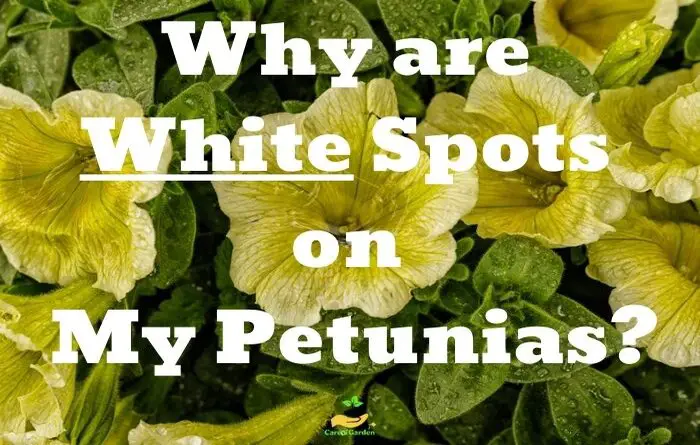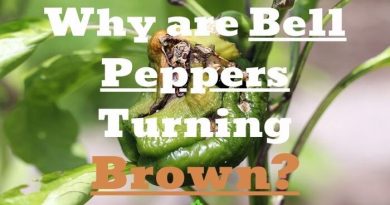Why are White Spots on My Petunias? (Quick Answer)
Do you have white spots on the leaves of your petunias? If the leaves of the petunias are covered with a white coating, then most likely it is powdery mildew.
Powdery mildew is a fungal disease that can affect petunias. In the event of an infestation, the petunias leaves initially show a white coating or spots, later the leaf withers and dies. Warm, muggy summer weather or large temperature differences between day and night can promote the development of powdery mildew.
In this article, we will analyze the main cause of this unpleasant phenomenon and show you how to prevent and remove this disease.
Powdery Mildew
On petunia leaves, powdery mildew appears as white spots. At the initial stage of the disease, it can be recognized by the whitish powdery coating that appears on the top of the petunia leaves. But striking, the disease is rapidly moving to flowers and buds.
Powdery mildew is a disease caused by fungi that usually affects adult petunias. Disease begins to manifest itself as white spots on young shoots and the root part of the petunias. First, leaves that are close to the soil are affected. Initially, small droplets of moisture appear in this “white dust”.
If you look closely, then on the leaf plates where the mycelium is attached, you can see tiny sores caused by the fungus. This fungus is a real pest that invades the cells of the leaves and absorbs the nutritious juices from the petunia as a result the process of photosynthesis is disrupted and the petunias leaves turn white.
After a few days, the flower begins to fade before our eyes, the leaves atrophy very quickly. Fungal formations eat the tissue of the flower and ulcers form on the leaves.
The powdery mildew occurs on petunias mainly in spring and summer and finds the optimal conditions to develop in the presence of humidity and temperatures above 68°F (20°C).
The strong temperature variations between day and night and the frequent rains are optimal conditions for the development of powdery mildews on petunias leaves.
Why does petunia get powdery mildew?
Petunia infection with powdery mildew is caused by the following factors:
- Decrease in air temperature to 59 °F (+15 ⁰С) and high humidity (above 70%), if the petunia is in a flower bed or on a balcony.
- A lack of sunlight.
- High nitrogen content in the soil.
- Overcrowded planting, therefore, insufficient air circulation between petunias.
- Lack of regular pruning.
- Watered too often(waterlogging).
- Watering the plant after a long drought.
Powdery mildew can appear on petunias when their flowers have been watered with water that was contaminated by fungi or when the flowers have been touched with hands that had previously touched infected flowers.
In addition, powdery mildew can appear on petunias if the wind carries fungal spores from infected bushes to healthy ones.
How to treat white spots caused by powdery mildew
As soon as the first signs of powdery mildew appear on petunia leaves, rapid action is required.
The first action is to remove any affected petunia leaves. Since powdery mildew is toxic or forms toxic substances, it is important to combat it quickly. Otherwise these substances could be deposited in the soil and also damage other plants.
If the infestation is severe, pruning is recommended. You should never store the green waste, the leaves on the compost or in the garden.
The fungus continues to multiply there, which is why renewed contamination can occur quickly. It is better to dispose of them in the organic waste or to take them to a suitable disposal point.
Clean affected surfaces with high pH water. You should use water with a pH of 8.0-8.2. This will make the surface uninhabitable for the powdery mildew spores.
Using a good pair of pruning shears, remove all dry or yellowed leaves. This helps redirect the plants energy, since the affected foliage will die anyway.
Instead, cover the top layer of soil with fresh compost. This will prevent the spores from splashing onto the petunia when you water.
As soon as a white coating is found on the leaves of a petunia, it is necessary to immediately begin treatment of the plant:
- You can combat powdery mildew with a mixture of milk and water . Use either raw milk or buttermilk and mix one part milk to nine parts water. Then spray this mixture several times a week on the affected petunia plants, where the lactic acid bacteria counteract the fungus. Positive side effect: the sodium phosphate from the milk strengthens the plants and has a protective effect.
- The use of baking soda against powdery mildew of the true genus has also proven itself. Add a packet of baking soda to two liters of clear water and mix the mixture with 20 milliliters of oil. It is sufficient to spray the mixture on every 2 weeks. The fungus cannot survive in an alkaline environment.
- Another remedy for powdery mildew is a mixture of three teaspoons of baking soda, one drop of dish soap, one liter of water and ten milliliters of oil. You can simply spray the liquid on the petunia plants and repeat the process about every two weeks.
| Treatment against powdery mildew | Description |
|---|---|
| Treatment with copper sulfate | For 5 liters of water, take 5 g of copper sulfate, add 50 g of laundry soap and mix thoroughly. Treat the petunia with the resulting solution once a week for a month. |
| Potassium permanganate | Dissolve about 3 g of manganese in 10 liters of water. Treat the petunia with this solution 3-4 times every 5 days. |
Sodium carbonate | Prepare a soda solution: for 5 liters of hot water, take 2 tablespoons of soda and 1 tablespoon of laundry soap. Spray petunia bushes with a warm solution 3 times in 7 days. |
Eggplant leaves turn white from a variety of causes and in this article I will show them all!
How to prevent white spots on petunias
White spots caused by powdery mildew on petunias can be prevented quite well in a number of ways:
- Petunias need to be watered with warm, settled water during dry weather to prevent wilting.
- During dry weather, provide plenty of extra water so that the plants do not weaken.
- Thin out petunias periodically by removing slower-growing shoots first.
- When fertilizing petunias, use less nitrogen-based fertilizer.
- Use potassium-phosphorus mixtures for your petunia to help develop immunity against fungal diseases.
- Inspect your petunias daily for signs of fungal disease and remove infected leaves as soon as possible.
- Don’t plant your petunias too close together so that they get enough air.
- Once the soil has been infected with a fungal disease, it is wise not to plant any more mildew-sensitive plants in that place.
- Carry out frequent loosening to saturate the soil with oxygen.
- Spray petunias periodically with a biofungicide to prevent spread of powdery mildew infection from one plant to another.
Always on a preventive level, we can use biological biostimulants capable of increasing the natural defenses of plants: some are based on Propolis or natural extracts ( Echinacea, Aloe ) and mineral salts and have the ability to stimulate the biosynthesis of endogenous substances which fortify the tissues of the petunias, making them more resistant and inhibiting the development of fungi.
A good advice may be to water the plants trying to wet the branches and leaves as little as possible and avoid harmful stagnation of water in pots or in the ground.
Especially in the presence of favorable climatic conditions for the development of powdery mildew, i.e. high temperatures and a lot of humidity.
By following these simple rules, you can give petunias a long life, and yourself the joy of the positive results of your work.
Conclusion
White spots on petunia leaves are a sign of powdery mildew. Such a problem appears due to temperature differences, high soil moisture and fungal infection, and an excess of calcium. You can fight the problem with the help of chemicals or home-made remedies.




